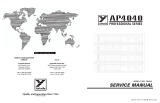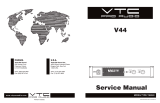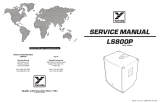Page is loading ...

Klone V4
Ultimate box of
transparent overdrive
Contents of this document are ©2017 Pedal Parts Ltd.
No reproduction permitted without the express written
permission of Pedal Parts Ltd. All rights reserved.

Important notes
If you’re using any of our footswitch daughterboards,
DOWNLOAD THE DAUGHTERBOARD DOCUMENT
•Download and read the appropriate build document for the daughterboard
as well as this one BEFORE you start.
•DONOT solder the supplied Current Limiting Resistor (CLR) to the main
circuit board even if there is a place for it. This should be soldered to the
footswitch daughterboard.
POWER SUPPLY
Unless otherwise stated in this document this circuit is designed to be
powered with 9V DC.
COMPONENT SPECS
Unless otherwise stated in this document:
•Resistors should be 0.25W. You can use those with higher ratings but
check the physical size of them.
•Electrolytics caps should be at least 25V for 9V circuits, 35V for 18V
circuits. Again, check physical size if using higher ratings.
LAYOUT CONVENTIONS
Unless otherwise stated in this document, the following are used:
•Electrolytic capacitors:
Long leg (anode) to square pad.
•Diodes/LEDs:
Cathode to square pad. Short leg to square pad for LEDs.
•ICs:
Square pad indicates pin 1.

Schematic
BOM
R1 10K
R2 2M
R3 5K1
R4 1K5
R5 1K
R6 10K
R7 1K5
R8 15K
R9 47R (2K)
R10 15K
R11 422K (420K IS FINE)
R12 1K
R13 47K
R14 22K
R15 10K (27K)
R16 4K7 (12K)
R17 392K (390K IS FINE)
R18 4K7 (1K8)
R19 100K
R20 100K
R21 1K8 (4K7)
R22 560R
R24 100K
R26 560R
R27 100K
R28 2K2**
R29 27K
R30 27K
R31 2M
D12 D9E*
D3 LED
D45 1N4001
D6 12V zener
rated min 1W
IC12 TL072
IC3 7660S*
VOL 10KA (10KB)
TONE 10KB
GAIN 100KB
DUAL GANG
C1 100n
C2 68n*
C3 390n (330n IS FINE)
C4 100n
C5 68n
C6 82n*
C7 1u tant
C8 390p
C9 1u elec
C10 1u elec
C11 2n2
C12 27n
C13 560p (820p)
C14 3n9*
C15 4u7 elec
C16 4u7 elec
C17 47u elec
C18 1u elec
C19 1u elec
C20 47u elec
C21 1u elec
C22 1u elec
BOM is for Silver Pony version.
Gold version values shown in blue.
If using a 7660 for IC3 you need one with an
S suffix. This ensures it will operate at a
frequency high enough to be inaudible.
*There are a few value substitutions we
recommend - see next page for details and a
note regarding diodes.
**R28 is the current limiter for the LED. This
is now located on the footswitch
daughterboard and is marked ‘CLR’.

*The diodes we supply with the kit are
Russian D9E. On these the stripe indicates
the anode rather than cathode, so they should
be placed on the PCB the opposite way to that
shown on the silkscreen. That being said, they
are in a top-to-tail configuration, so it really
doesn’t matter.
The Buffered/True-Bypass selection is
designed for a 2.54mm-pitch miniature slide
switch.
If you prefer to hardwire one way or the other,
wire in jumpers as shown above. Red for True
Bypass, blue for Buffered.
Snap the little metal tag off the pots to mount
them flush in the box.
You should use some kind of heat sink on the
legs of the diodes when soldering. They aren’t
keen on heat. Any more than 3-4 seconds of
iron and they’re toast. Use sockets for the ICs
or be extra careful with them too.
Footswitch lugs should be horizontal as
indicated above.
The current limiting resistor for the LED goes
into the spot marked ‘CLR’ on the
daughterboard. We supply 2K2.
Be VERY careful when bending the legs of the
germanium diodes. The glass case is very
fragile and likely to break. Hold the leg with
some needle-nosed pliers against the case,
and bend the leg with your finger so the
pliers are taking any strain away from it.
To give yourself more clearance when
mounting the circuit into your enclosure,
C17 and C20 can be bent over the adjacent
components as shown in the cover image.
Connect the two PCBs together using pads
1 2 V G 3 4
Your jacks connect to G / IN and G / OUT on
the daughterboad.
DC connections are G and V pads next to
‘TRUE’.
PCB Layout ©2017 Pedal Parts Ltd.
PART SUBSTITUTIONS
The circuit benefits from some extra bass in
both the gain and clean sections:
C2 100n (clean)
C6 120 - 150n (gain)
The Tone (Treble) control has a more useful
range if you increase C14 to 6n8 or 8n2.
Footswitch lugs should be horizontal

The best way to get the pots lined up
is to first solder one pin of each.
Once they’re tacked in place adjust
them so they’re straight and check to
see if the heights line up. If not, melt
that soldered joint and adjust. Once
you’re happy all the pots are aligned
you can solder in the other legs.
Make sure you don’t push the pot
pins all the way into the PCB.
There’s not a lot of clearance
on the bottom of the dual gang,
so it has to sit a little way up
from the PCB.

Keep it simple...
No charge...
You can eliminate the charge pump if you
prefer. It’s only in there to give IC2 more
headroom and avoid clipping. Is there any
need? The signal is already clipped by the
diodes anyway.
To leave this out and avoid any potential
whining issues associated with charge
pumps, do the following:
Leave out:
C18, C19, C21, C22
D4, D5
IC3
Place jumper wires in place of:
D4, D5, C19
No buffer...
If you prefer to keep things True Bypass and
you want to use your own daughterboard you
can get rid of the buffered bypass element.
Leave out:
R24, R26, R27
C16
Take wires from the following pads to your
daughterboard or switch wiring.
2 - IN
3 - OUT
V - +Volts
G - Ground

Wire it up - switching board

Wire it up - true bypass

Wire it up - buffered bypass
Sorry, it’s not particularly elegant, but pad 1 from the
main board should connect directly to the footswitch lug
as shown. It should actually work fine without this wire,
but it follows the original in that it grounds the output of
the gain section on bypass.

2
4
3
1
What’s going on with those switches?
Here’s what’s connected to what...
Jack
IN
Jack
OUT
GND
BUFFERED
TRUE BYPASS

This template is a rough guide only. You should ensure correct marking of your
enclosure before drilling. You use this template at your own risk.
Pedal Parts Ltd can accept no responsibility for incorrect drilling of enclosures.
FuzzDog.co.uk
Drilling template
Hammond 1590B
60 x 111 x 31mm
It’s a good idea to drill the pot and
toggle switch holes 1mm bigger if
you’re board-mounting them.
Wiggle room = good!
Recommended drill sizes:
Pots 7mm
Jacks 10mm
Footswitch 12mm
DC Socket 12mm
Toggle switch 6mm
22mm
32mm
1/11















